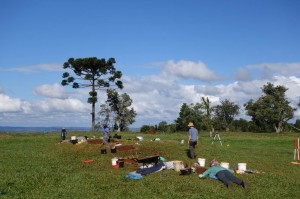A lot has happened since our last blog post in December! Heather and Richard successfully submitted their PhDs, James, Josie and I all had our PhD registration confirmed, and Frank has been awarded a significant grant from the AHRC (UK Arts and Humanities Research Council) and FAPESP (São Paulo research council, Brazil) for a major upcoming project. But while each of these things could probably have a post to their own, I wanted to give a bit of space here to look at a paper that Maca, Frank and I have recently had published.
Brazil’s Araucaria forests are iconic, diverse and ancient, but they’re also among the country’s most threatened ecosystems. 20th-Century logging reduced their area by up to 97% and, with their adaptation to relatively cool, constantly moist conditions, climate change is a looming threat. To understand how the forests will react it’s important to learn from their responses to past climate changes, but this is complicated because human activities may also have shaped the region’s vegetation dynamics in the 1,000 years or so.
Our study aimed to help disentangle these two drivers of change in the Araucaria forests by giving key insights into how the biome is represented by its key palaeoecological proxy, fossil pollen. We aimed to find out how well pollen rain could tell apart structurally different forest patches, and how over- or under-represented key trees were in their pollen. Although Araucaria forests’ modern pollen rain has been described before, this was the first time its relationship with the vegetation has been described in a quantitative way.
We found that, although structural differences between the forest plots were plain to see, they weren’t clearly reflected in the patches’ floristic composition. Pollen tends to have lower taxonomic resolution than vegetation surveys (it’s difficult – sometimes impossible – to tell the pollen of closely-related species apart), so it was therefore unsurprising that the plots couldn’t be distinguished by their pollen rain either. It’s possible that bigger or longer-standing structural differences would have been detectable, but this finding suggests that subtle human impacts in Araucaria forests may not be easy to pick up with fossil pollen.

This figure shows the differentiation of the forest plot types according to their vegetation (top row) and pollen (bottom row). Plot types are denoted by their colour and by their suffixes (op=open, cl=closed, di=disturbed, ro=rocky outcrop, sl=slope). The lack of coherent clusters in panels a and c, and the close spacing of the various plot groupings in b and d, show the patches’ similarity.
The difficulty of identifying complex changes in the forests is further emphasised by our second main finding. We calculated p/v values (a taxon’s pollen abundance divided by its abundance in the vegetation) for 27 tree genera. A p/v value of 1 would mean that a tree is equally present in both pollen and vegetation, a value of 2 would mean it’s twice as common in the pollen rain as in the landscape, a p/v of 0 means a plant’s growing nearby but isn’t found in the pollen sample, etc. Only five genera had p/v values higher than 1; by contrast, four had p/v values of 0, and 16 others had values less than 0.5. This means that pollen only provides good information on a small minority of the trees in this highly diverse forest – changes in the many under-represented taxa simply may not be captured. Logically, the over-represented taxa are the ones most often cited in palaeoecological studies, but these results suggest that analysing changes in rarer pollen types may also be important for understanding the ecosystem’s dynamics.

p/v values for 27 key Araucaria forest tree genera. Clethra technically has an infinite score (found in the pollen but not the vegetation survey); the paler sections for Lamanonia and Lithraea reflect different ways of calculating their values.
We hope this research helps find plot a path towards a fuller understanding of how past human and climate impacts on Araucaria forests are reflected in fossil pollen analyses. And, by putting numbers on the relationships between the forests’ trees and the pollen they produce, we hope to enable the increasingly accurate interpretation of these vital palaeoecological records.
Oli
Our study is published in Review of Palaeobotany and Palynology (https://doi.org/10.1016/j.revpalbo.2019.03.003). You can read and download it for free before the 22nd of May 2019 at this link: https://authors.elsevier.com/a/1YqF97uTvRX4z. After that date, please get in touch if you want to read the article but can’t access it online.
Macarena L. Cárdenas, Oliver J. Wilson, Lauri A. Schorn, Francis E. Mayle, José Iriarte (2019), A quantitative study of modern pollen–vegetation relationships in southern Brazil’s Araucaria forest. Review of Palaeobotany and Palynology 265, p.27-40, https://doi.org/10.1016/j.revpalbo.2019.03.003.



